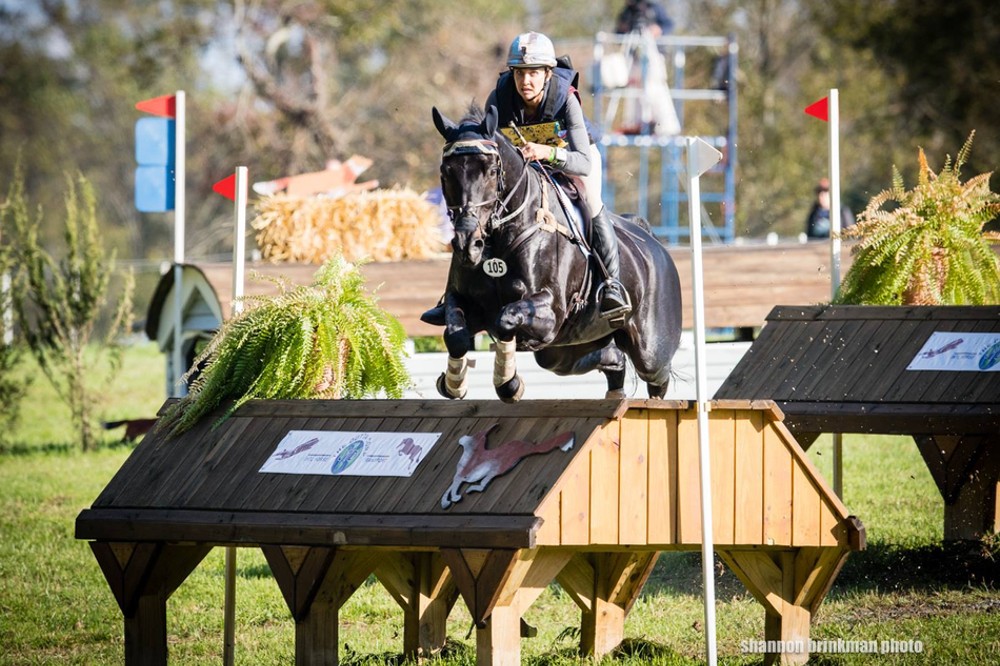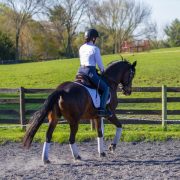Lessons from the Live Stream: Jim Wofford on Cross-Country Riding

This past weekend, US Equestrian members were treated to a special appearance from eventing legend Jim Wofford as he provided commentary alongside Jenni Autry at the Dutta Corp. Fair Hill International. As is often the case with a live stream, viewers can pick up tidbits of expertise and knowledge, which is exactly what we got in listening to Jim.
Here are a few tips we can all use in our riding, no matter what level.
Put your hands down and kick.
Jim was quick to compliment riders who rode forward to their distances on Derek di Grazia’s testing cross-country course. A longtime proponent of forward riding, Jim reminded us that a lowered hand (i.e. not up and pulling) encourages the horse to move into the contact and jump more out of stride – which allows the rider to land in a forward motion on the opposite side, therefore saving time and energy.
Don’t spend too much time setting up.
“Boyd (Martin) rides fast because he doesn’t spend too much time setting up,” Jim commented as Boyd expertly piloted Peter Barry’s Long Island T around. It’s true – Boyd is one of the quicker riders across the country, so it’s worth watching. Comparatively, you could see his tracks taking less space, more of a direct route, than others. Of course, safety is paramount but not spending 18 strides gathering your horse up for an innocuous “fly” fence will save you time in the long run.
Use your turns to balance your horse naturally.
This goes in line with Jim’s previous point about setting up too much. Early on in the CCI3* course, Derek put riders on a sweeping turn that led them to the first combination on course. This turn, Jim said, would naturally balance the horse for the upcoming question, eliminating the need for riders to make futile last-minute adjustments with their reins. On any course, as you’re walking it, pay attention to the turns and how they can help set your horse up in a good balance. The designer wants you to use this terrain to your advantage, and every path is set for a specific reason.
The hardest horse to make time on is the hot horse.
Several horses presented as strong and “hot” out on course, which caused their riders to have to take a strong hold in between to keep control. While each horse has its own style, Jim encouraged the more even-mannered horse more so than the hot one. He described a “yo-yo” or “slinky” effect of having to constantly compress and then kick to try to make up time, followed by another stride compression before each jump. This, Jim said, creates too much of a back and forth and makes it much tougher to make time.
Want more opinions? Read Kyle Carter’s op-Ed on what types of horses are the most competitive.
Envy taller riders all you want – they still have a lot of managing to do.
It’s true – most of us wish we were blessed with longer legs or leaner body types. But, Jim says, don’t despair too much. Taller riders still have what he calls a “lever effect” on their horse’s balance. With long legs often comes a tall torso, so the positioning of the upper body can have a much more pronounced effect on the horse than, say, a shorter rider with a lower center of gravity. Short riders rejoice – there’s hope for us yet.
Riding a lot of horses benefits you in the long run.
As Buck Davidson gave Maya Simmons’ Archie Rocks a flawless ride, Jim observed that the pair seemed to be forging a great partnership, even though Buck’s only had the ride for a few months. This is because Buck rides such a wide variety of horses that “he can form partnerships easily.” It’s worth noting – riding many horses, be it through catch-riding, training opportunities, or just for the heck of it, is beneficial as it gives you more tools to work with as a rider. Buck, fondly known as a truly versatile rider who could ride a broomstick if he had to, exemplifies this each and every time he sets foot out on a course.
Sometimes, you just have to make a mistake.
Coaches are great. We couldn’t do a whole lot without their help. But a coach can only tell you to close the left shoulder so many times before you either fix it or have a problem because you didn’t fix it. In many cases, the niggling issues that plague you at home can cause you to come to grief at a show – but that’s OK! Sure, it’s not an ideal time, but sometimes you have to make the mistake before you can truly understand how or why you need to fix it. Mistakes make better riders – remember that.
Want to learn from Jim yourself? Watch the cross-country replay on USEF Network here.


